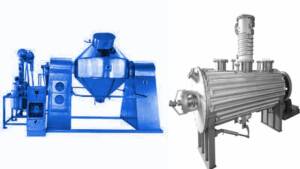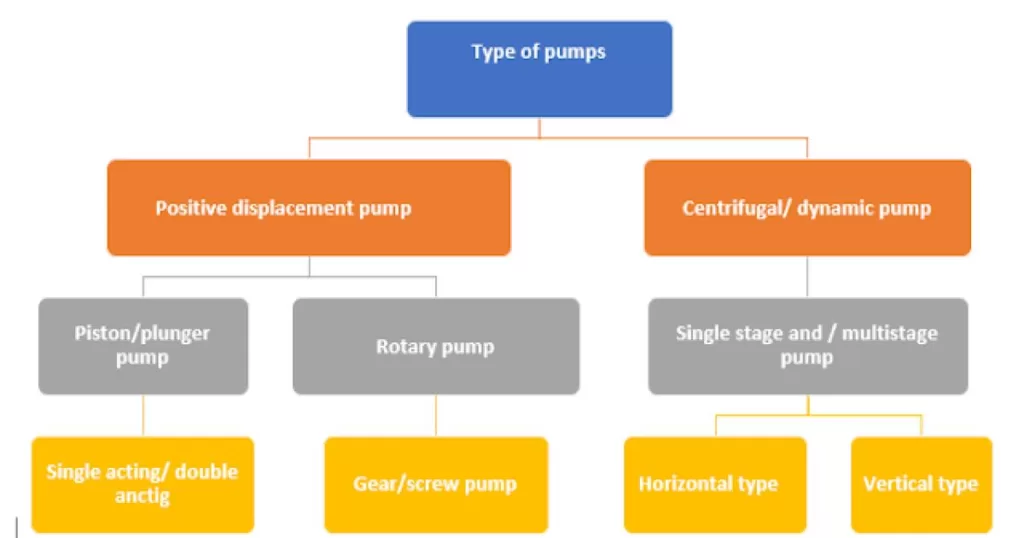What is a Rotary vacuum dryer (RVD) ?
Rotary vacuum dryer is a cylindrical or cone vessel integrated with jacketed or limpet coil and rotated by a hollow shaft. Basically this is used for a batch operation plant. The complete drying of the product is done by combination process of under vacuum, stirring / agitation and consistent heating is through a jacket. It is an efficient method that offers a drying of the slurry product with quality. Generally this dryer is designed to remove moisture content from product materials under consistent heat and heat and vacuum.
Function of a Rotary vacuum dryer
RVD is also used for changing a material’s molecular and physical properties of materials in specialized operations, including chemical reactions for the chemical and pharmaceutical industries. RVD does rapid drying at low temperatures of press cake, filter cake and slurry materials but that is also required subsequently stirring / agitation.
There are two types of agitators used in this system these are paddle types and blade types and the clearance between blade and inside shell is very close. The main purpose of agitators is to distribute product materials over inside vessels. RVD rotates with shafts on both ends supported by high performance bearing and driven by electric motor and reduction gear box. RVD, Gearbox, and motor may be connected with direct couple or by belts systems.
What is the full form of RVD?
The full form of RVD is Rotary Vacuum Dryer.
- R – Rotation
The Rotary Vacuum Dryer operates under the principle of rotational motion. The Rotary Vacuum Dryer is a cylindrical jacketed vessel with a central agitator having specially designed blades. A hollow shaft with suitable seals forms the drive connection to impart rotation to the dryer shell, thus allowing material to tumble inside it and also in contact with the heated surface of the inner wall. - O – Operation
The vacuum dryer takes so long during its loading and unloading periods due to its complete tightness. On starting operation of RVD, material is first taken into a heated pouch which subsequently moves further into a rotating tube where due to centrifugal forces the wet material gets thrown against the sides of the heated cylinder where it cools down by giving off vapors and water instantly, entered into drying process with the help of a single nozzle jet system controlled from the PLC panel. - T – Temperature
Temperature plays an important role in Rotary Vacuum Dryers operations; hence there is a temperature control mechanism provided for controlling temperature at the desired level as per requirements. Rotary vacuum dryers are most heat sensitive products processed at low temperatures up to 140°C resulting in excellent quality products with longer shelf life & lower energy consumption as compared to other methods such as spray/flash drying etc. - A – Agitation
The machines have a unique design that helps mix and agitate materials during the processing cycle, thus providing homogeneous blending. Excellent product results and high output capacity are comparable advantages experienced when using RVD’s compared to other equipment used for drying purposes in industry . The agitation helps efficiently proper drying process mechanism & helps break bonds formed between the particles on their surfaces aiding them in reducing viscosity & improving properties like solubility , particle size reduction & abrasion resistance of the end product. - R – Reactivity
RVD proves beneficial in case of reactive compounds thanks to its low peak residence temperature that decreases the possibility of degradation or decomposition thus maintaining purity & quality. By setting specific rates & timing for feed rates / outlet valves / vacuum pumps etc. controls set according to stability of end products can be obtained . One drawback about reactivity, however, is mentioned in the fact that long residence time may lead in some end products reaching equilibrium state before being extracted from the dryer. - Y – Yield
Yield depends on a lot of factors, but important ones being the degree of vacuum achieved , heating rate & duration at which the same temp is maintained (i.e., dwell time). 3 theoretical cases exist: High yield- Material gets cool slowest Moderate yield- Material cooled at moderate speed Low yield – Cooling was too fast leading to reduced yield Efficiency can be further increased by various means like continuous crust breaker , eliminating hot spots , insulated electrical heaters etc Making sure best practices are followed. One should be able to select the most optimal condition based upon capacity requirement. - D – Design
Rotary Vacuum Dryers vary greatly in terms of design features right from internal components such as screw conveyor arrangement ,cycle timer arrangement, nozzles configuring achievable vacuum levels , temperature range selection fluctuation prevention device selection As they come in many shapes and sizes ( cylindrical conical twin drum spherical) it’s always better to select one keeping production goals,material characteristics usage, smooth flow in mind otherwise latest models available on market depending upon efficient co-production strategies like batched wet scrubbing or thin film vac or thin layer applied could enhance output capacity without affecting quality.

The cooling and heating is provided through jackets or limpet systems as per installation with the vessel and main purpose for this is protection of contact between product and heating and cooling media. The drying completion time is not fixed because it depends on the quantity of solvents present in product materials.
- Technical details Operational Temperature: 0-200°C and Heating Temperature: 30°C to 300°C.
- Capacity: 200 – 10,000 liters but for vacuum paddle dryer 100 – 25000 liters depends on the size of the vessel.
- Atmospheric to Full Vacuum: Up to 0.6 torr it is dependent on product specification requirements. The requirement of vacuum is to increase the boiling point of product solvents.
- Rotary vacuum dryer is efficient to dry many types of processed materials like slurries to solid shapes, granular, crystalline or fibrous solids such as centrifuged solids, Pharmaceuticals, Pigments and Synthetic rubber.
Parts of Rotary vacuum dryer (RVD)
Some important parts of RVD are drive unit motor and gearbox, agitator, vacuum equipment like pump, condenser, dust catcher, material charging door, solvent receiver, discharge nozzle, sealing element like mechanical seal etc.
How many types of Rotary vacuum dryer (RVD) ?
Basically (RVD) is classified and customized in many categories depending on the requirements and function. Here explain the types of construction and drive arrangement.
- Vacuum Paddle Dryer
- Cone type with Limpet coil and (direct couple or belt drive with reduction gearbox).
- Cone type with Limpet coil and (direct couple or belt drive with reduction gearbox).
- Horizontal cylindrical type with jacket and (direct couple or belt drive with reduction gearbox).
Horizontal cylindrical type with Limpet coil and (direct couple or belt drive with reduction gearbox).
Advantage of Rotary vacuum dryer
- Efficiently heat transfer
- Uniform drying process
- Good solvent recovery capacity
- Less time cycle time for one batch process.
- It is power consumption and useful for cost reduction.
- Less hazards at the workplace because of the closed system process.
- Low pressure and temperature drying processing of highly toxic materials
- No degradation of dry product due to over-exposure, more temperature and time.
- Automated discharge of product with condenser of moisture and recovery of solvents.
Disadvantage of a vacuum rotary dryer
- More complex system arrangement
- Mechanical seal is a expensive part of the system
- Specialization required for design, process and operation
- Leakage of steam is a big issue due to rotating and static parts
- Vacuum build up and agitation in running condition is a critical task
Working principle of rotary vacuum dryer
RVD (Rotary vacuum dryer) is mechanical equipment which is used to remove moisture from products under vacuum by providing additional heat sources like steam, hot water and other.
- Take batch of product for dry in dryer as designed and requirements and close the door
- Create vacuum as per product nature and boiling point.
- Provided heat source by steam or hot water as availability and requirements.
- Start rotating the dryer by the help of drive equipment like motor and gearbox at very slow speed.
- Agitator is also an integral part of the dryer so it also works accordingly to distribute product material equally.
- And finally get the product as desired at the completion of the process after some time.
Rotary vacuum dryer diagram

Feature and combination of RVD
- Available with Direct drive and belt drive and Available with Mechanical seal arrangement
- Available Pulse jet dust filter arrangement and Sampling valve and Breaker bars arrangement
- Product temperature and vacuum probe arrangement and Rotor Types: Helical Ribbon, Paddles, and Special.
- Heating Surfaces: Shell, End Covers, and Shaft and Heating Media: Steam, Hot Water/Oil, Thermic Fluid.
- Suitable for drying heat sensitive material, as low temperature for drying can be maintained by high vacuum.
- Higher Thermal Efficiency.Almost 100% recovery of solvents.
- Heating Temp.: From 30°C to 300°C.
- Limpet coil could be provided instead of jacket if the heating media is fluid.
- The Evaporation Rate 4-12 Kg/H/Sq.m approx of heating surface area of water at heating temperature of 100°C.
- Nitrogen purging arrangements provided for bag cleaning done with pulsation by nitrogen jet injector.
Materials selection for RVD
The selection totally depends on product nature which has to dry. But some of the most commonly used materials are CS, SS 316, 304, SS316L, SS304L, Monel, Inconel, Titanium, Hastelloy etc.
- Install Grid Coupling
- Select Shaft Coupling
- Reciprocating Pump
- Centrifugal Compressor
- Gear Coupling
- Wearing Rings
- Fluid Coupling
- Rigid Coupling



